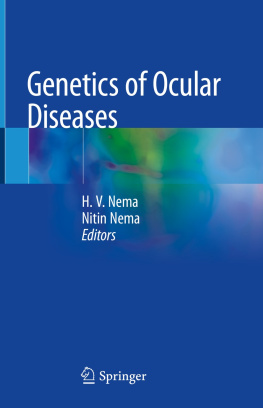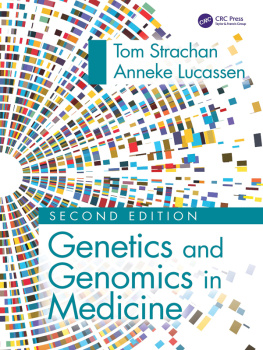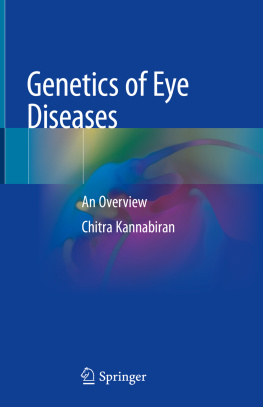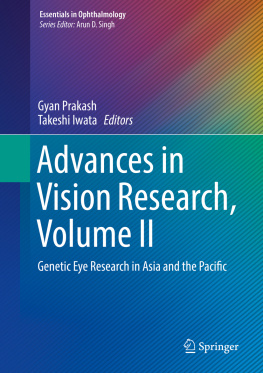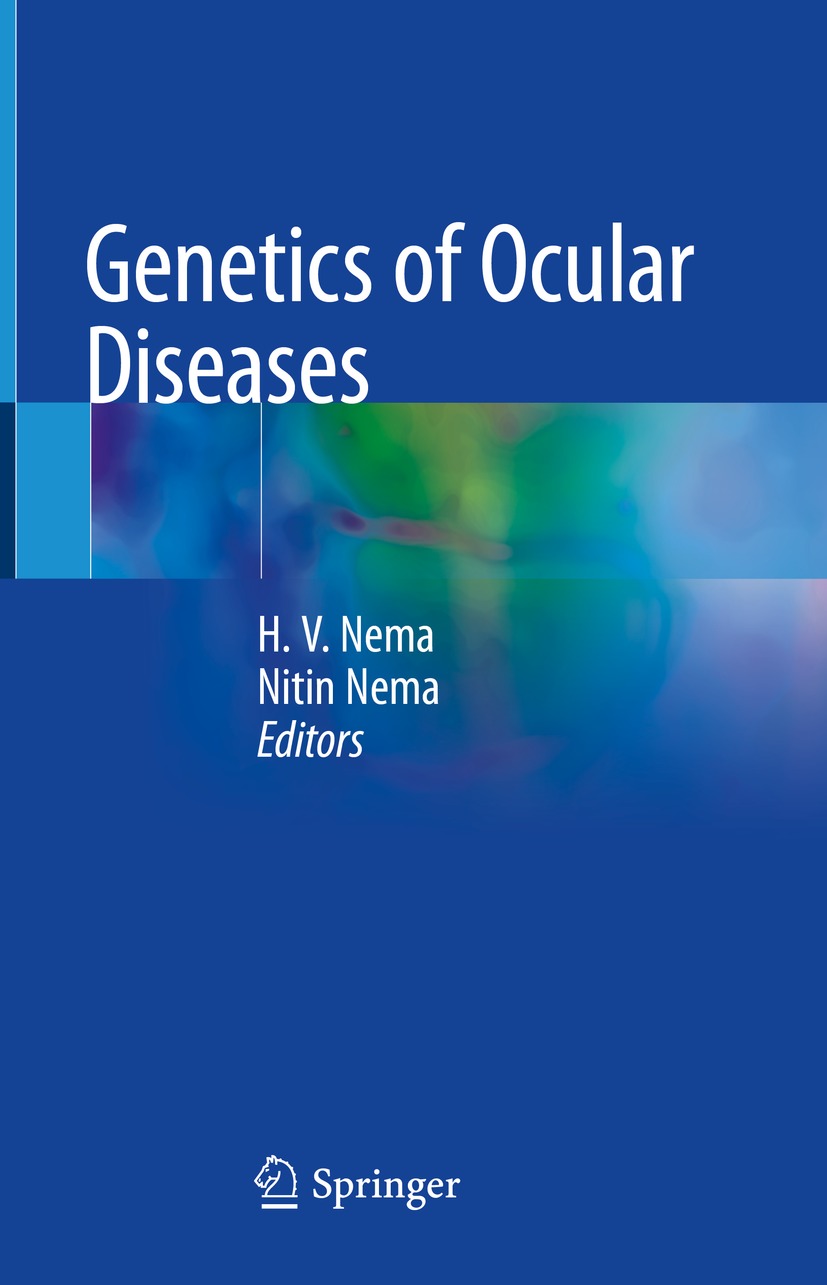Editors
H. V. Nema and Nitin Nema
Genetics of Ocular Diseases

Logo of the publisher
Editors
H. V. Nema
Department of Ophthalmology, Institute of Medical Sciences, Banaras Hindu University, Varanasi, Madhya Pradesh, India
Nitin Nema
Department of Ophthalmology, Sri Aurobindo Medical College and PG Institute, Indore, Madhya Pradesh, India
ISBN 978-981-16-4246-3 e-ISBN 978-981-16-4247-0
https://doi.org/10.1007/978-981-16-4247-0
The Editor(s) (if applicable) and The Author(s), under exclusive license to Springer Nature Singapore Pte Ltd. 2022
This work is subject to copyright. All rights are solely and exclusively licensed by the Publisher, whether the whole or part of the material is concerned, specifically the rights of translation, reprinting, reuse of illustrations, recitation, broadcasting, reproduction on microfilms or in any other physical way, and transmission or information storage and retrieval, electronic adaptation, computer software, or by similar or dissimilar methodology now known or hereafter developed.
The use of general descriptive names, registered names, trademarks, service marks, etc. in this publication does not imply, even in the absence of a specific statement, that such names are exempt from the relevant protective laws and regulations and therefore free for general use.
The publisher, the authors and the editors are safe to assume that the advice and information in this book are believed to be true and accurate at the date of publication. Neither the publisher nor the authors or the editors give a warranty, expressed or implied, with respect to the material contained herein or for any errors or omissions that may have been made. The publisher remains neutral with regard to jurisdictional claims in published maps and institutional affiliations.
This Springer imprint is published by the registered company Springer Nature Singapore Pte Ltd.
The registered company address is: 152 Beach Road, #21-01/04 Gateway East, Singapore 189721, Singapore
Foreword
It is a distinct honor for me to write the foreword for this important and timely book on the genetics of eye diseases that includes the work of several key leaders of eye genetics research. It is a very valuable presentation of the current knowledge that provides and outlines the future potential in the field of eye genetics in combating global blindness.
According to the World Report on Vision (October 2019), at least 2.2 billion people around the world have a vision impairment, of whom at least 1 billion have a vision impairment that could have been prevented or still need to be addressed. Furthermore, 90% of the global burden of eye diseases is shouldered by developing countries, where many treatable diseases often go undiagnosed. A comprehensive research strategy and international research collaborations between the developed and developing worlds are needed to address the prevention of global blindness. A wider collaboration of researchers is needed to advance high-quality science in many areas of vision research as well as improve the standard of care. A coordinated strategy for basic science and translational research, involving the tools of genetics, genetic counseling, and health services research, will help in reducing the global burden of eye diseases.
Indian researchers have played a key role in the development of our knowledge on eye genetics from the beginning of this discipline. Many independent research programs have been developed in India leading to many valuable findings in the field. In addition, by participating in numerous collaborative programs and working with researchers around the world, the Indian laboratories have generated a wealth of knowledge that is helping in the advancement of science. For example, Indian scientists have played key roles in the Global Eye Genetics Consortium (GEGC) that originated as a collaboration between the National Eye Institute (NEI) at the National Institutes of Health (NIH) in the USA and the National Institute of Sensory Organs at Tokyo Medical Center in Japan in 2014. India is one of the few countries in the world at this time that has established a GEGC-India team. In the past five years, the GEGC-India members have conducted several high-quality training programs and established dedicated research labs to advance research in eye genetics. It is a fast growing field of research globally as well as in India that has encouraged many scientists and clinicians to establish new programs in various corners of India. Many Indian eye hospitals have brought geneticists and genetic counselors to work with the ophthalmologists to expand their services. I expect the field to expand significantly in the coming decade not only in India but in most parts of the world.
The field of eye genetics research is expected to grow significantly in India because not only many next-generation researchers are entering this field of research but also there are many unique populations across the country who are expected to provide useful information for many research developments on biomarkers and therapeutics. Several prominent international collaborative research programs are successfully being conducted in India, which are studying many patient populations with unique phenotypes and genotypes that until now have not been studied.
This book is very timely and expected to serve as a long-term resource for all those interested in working in this field. I am delighted to see that the book not only covers the genetic aspects of various common eye diseases, but it also covers the future applications through gene therapy and genetic counseling as separate chapters. The future programs include training and increased access to the new technologies to many research programs. Undoubtedly, the book will play a key role in providing the required background in training and research. It will further promote and provide guidance to many researchers and clinicians. I wish to congratulate and thank the authors and editors of the book for taking a lead role in expanding our knowledge in the area of eye genetics.
Gyan Prakash
Abstract
Retinitis pigmentosa (RP) is the most prevalent among the group of rare inherited retinal degenerative diseases (IRDs) leading to vision loss. RP is characterized by night blindness in the initial stages followed by progressive gradual decrease and loss of peripheral vision. The worldwide prevalence of RP is 1:4000 that varies in different geographic location. RP can be inherited as an autosomal dominant (adRP), autosomal recessive (arRP), X-linked (XLRP) or simplex trait; clinically present as isolated condition or syndromic (BardetBiedl syndrome, Alstrom syndrome, Ushers syndrome, Senior Loken syndrome, and Jouberts syndrome) with extra ocular abnormalities and partially overlapping genetic/clinical features. Inter and intra familial phenotypic variability, different mutation spectrum in RP explain the genetic heterogeneity in the disease. The overlapping genetic architecture and clinical heterogeneity pose challenge in diagnosis and molecular confirmation and differential diagnosis of the disease. In this book chapter, the current trends in molecular diagnosis of RP using next generation technologies like targeted panel, whole exome and genome sequencing. The implication of genetic diagnosis in checking the eligibility for treatment, future gene therapy trials, pre-implantation genetic diagnosis and thereby management. The other potential treatment strategies applicable in RP patients like optogenetics and cell based therapy that are under clinical trials.

